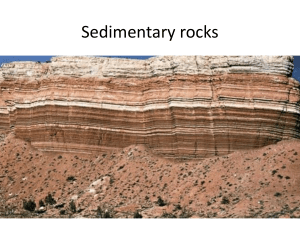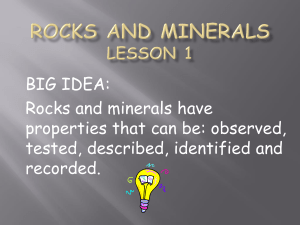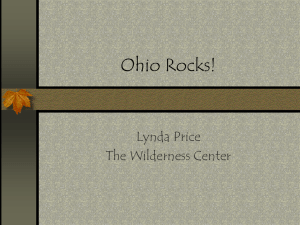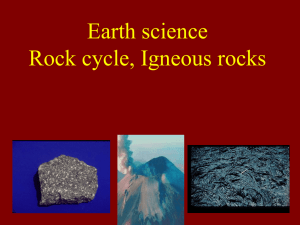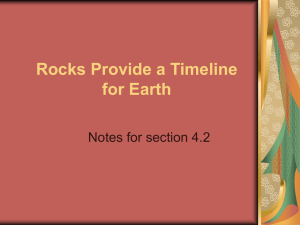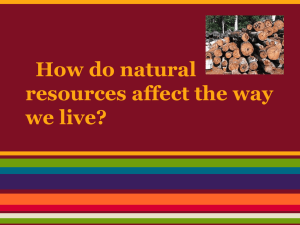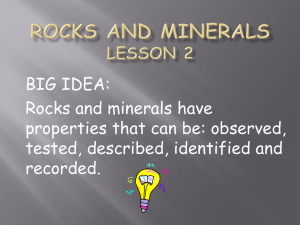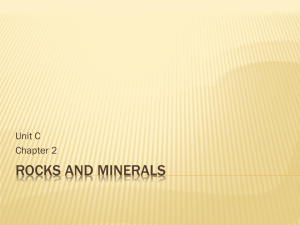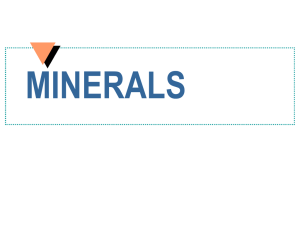Sedimentary Rocks & Depositional Environments Lab
advertisement
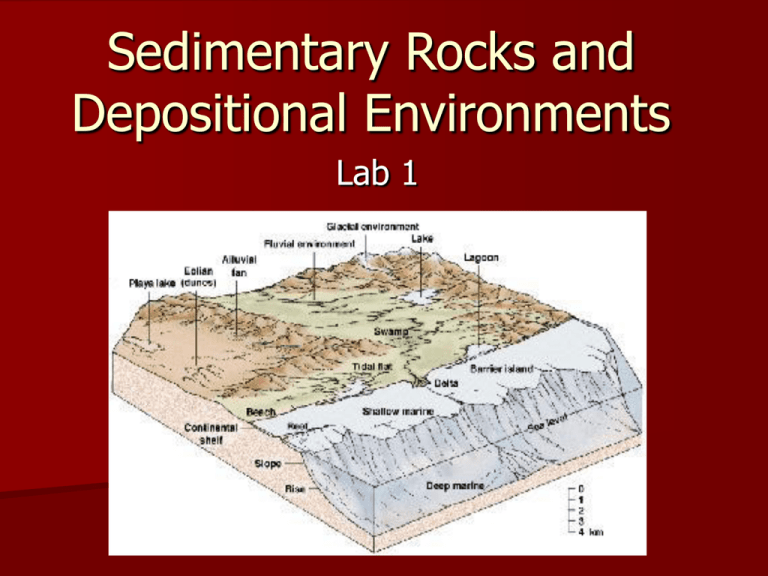
Sedimentary Rocks and Depositional Environments Lab 1 Rock Types - Background Igneous Metamorphic Sedimentary Broken down to form sediments – Sediments – fragments of rock, individual mineral grains (quartz), parts of plants or animals, clay minerals, and other minerals Minerals - Background Igneous, metamorphic, and sedimentary rocks are made of minerals Minerals – substances that make up rock; the building blocks of rocks Example minerals – quartz, potassium feldspar, biotite mica, muscovite mica, calcite Sedimentary Rock Characteristics Grain size Rounding Minerals Matrix Color Grain Size The average diameter of the particles Gravel > 2 mm Visible to the unaided eye Sand < 2mm, >1/8 mm Visible to the unaided eye, feels very gritty Silt (mud) <1/8 mm, > 1/256 mm Invisible to the unaided eye, can see with a hand lens, feels gritty Clay (mud) < 1/256 mm Cannot be seen without a microscope, feels smooth, dull luster Pg. 1-2 of lab manual ** Ruler in Back of AGI Manual ** Minerals Building blocks of rocks Mineral Hardness Cleavage Color Distinguishing Feature Quartz 7 None (fractures) Milky to Colorless Hardness and looks glassy Potassium feldspar 6 2 to 3 planes Salmon to Red Color Biotite mica 2.5 1 plane Black to dark brown Black flakes Muscovite mica 3 1 plane Colorless to light brown Light colored flakes; shiny Calcite 3 3 planes, rhomb White to Gray Reacts with acid (HCL) Pg. 1-3 of lab manual Matrix Sedimentary rocks are composed of large particles (grains) surrounded by smaller particles The smaller particles are the matrix The fill in between larger grains None—there are almost no open spaces Much Some All Sedimentary Environments A rock will display certain characteristics depending on the environment in which it was formed The study of the composition and other characteristics of the sed. rocks can reveal info. about the conditions occurring during deposition (helps determine environment) Sedimentary Environments Alluvial Fans River Channels Glaciers Swamps Deltas Beaches and Barrier Islands Dunes Lagoons Tidal Flats Reefs Continental Shelf, Slope, and Rise Deep marine environments Refer to Figure 1.1 pg. 1-2 Alluvial Fan Rivers in mountainous areas erode and transport sediment When meets flat plain deposits sediment in fanlike shape Common rocks: sandstone, conglomerate, breccia, diamicton River Channels Rivers vary in size and energy level Contain various sediment types (gravel, sand) Feldspar less common Common rocks: sandstone, conglomerate Glaciers Not able to sort sediment size Glacial sediments (till) are mixtures of gravel, sand, silt, and clay Rock types: diamicton Swamps Lots of organic matter Slow decomposition Buried and compacted organic matter hardens to form coal Common rocks: coal, shale Deltas Rivers flow into lakes or oceans Deposit sediment in a fan-like shape Mississippi River Delta, Nile Delta Large areas composed of various environments (channels, swamps, bays) Common rocks: shale, siltstone, sandstone, coal Beaches and Barrier Islands Barrier island is like a beach separated from the mainland by a lagoon Constant wave action separates sand sized grains from others Sediment has traveled far from source, so well rounded Common rocks: sandstone Dunes Form adjacent to beaches and barrier islands Contain non-marine fossils Common rocks: sandstone Lagoons Low-energy environment Fine grain sizes settle and accumulate (silt, mud) Common rocks: shale, siltstone Behind a barrier island or reef Barrier island/reef act as breakwaters protecting the lagoon from wave action Tidal Flats Broad, flat areas that are periodically covered in water when tide rises and dry when tide is low Variable energy levels Alternating layers of coarse and fine sediment Common rocks: siltstone, shale, limestone Reefs Organisms build large, rocky accumulations by cementing their shells or other structures Common in tropical regions (warm water) Calcite precipitates Common rocks: limestone Continental shelf, slope, and rise Shallow marine: extend from beach to water depths of 100 m; low energy; fine grains settle; common rocks are sandstone, siltstone, shale Deep marine: extend down to thousands of meters; low energy; fine grains settle; fossils are rare; common rocks are shale, sandstone Today’s Lab!! List properties of unknown sedimentary rocks Identify the unknown rock specimens (rock name) Determine possible depositional environment(s) where the rock formed Rock Names Shale Siltstone Sandstone Conglomerate Breccia Diamicton Limestone Coal

